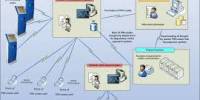The Basic Training Process in International Projects
Training has most emphasis to achieve the organizational objectives.
- Pre- Training
- Training
- Post Training
Pre-training: This is before training stage, where reason for training and types of training are determined.
Training: As stated earlier, is the process to increase the attitudes skills, and abilities of the employees to perform specific jobs.
Post training: This stage contains the evaluation of the training. It shows whether the training is effective or not.

Training as a System in INTERNATIONAL PROJECTS:
A training system for International projects may be defined as a rational arrangement of inputs, technology, people, materials, events and process designed to extract behavioral outputs, which produce further social or economical output, increasing organizational effectiveness. Training system receives a person as raw mat, a person having actual or potential deficiency in the job performance and process to modify behavior to match that has been specified in the training objectives. This is done under defined rating conditions and constrains. Feedback is from the trained person to refine the system. The process consists of several factors such as trainer, subject matter, training techniques and aids, physical features, time and money including operating conditions and constrains.
The Reasons for Employee Training and Development for INTERNATIONAL PROJECTS:
Training and development can be initiated for a variety of reasons for an employee as well as the group of employees:
- When a performance appraisal indicates performance is not up to the mark then there is a need for training.
- Helps people to identify with the goals
- Improve relationship between boss and subordinate.
- Helps to prepare guidelines for different types of work.
- Provides information for future needs in all areas of the organization
- Helps individuals in making better decisions effectively increasing the problem solving abilities.
- To eliminates fear in attempting new works.
PRE-TRAINING
From the name, it is easy to determine that all the activities that are carried out before the training process is known as pre-training. The goal of the PTA is to assess what level the users are at as a group, as well as individually. The trainers can prepare for the training accordingly and identify who needs more attention and help, and which users could potentially be helping fellow users. Furthermore, results can be used by the data team to analyze correlation between starter level and CommCare uptake/adoption.
Steps of Pre- Training of Pubali Construction for Int. Projects:
The pre-training stage can therefore be broken down into the following number of steps to be carried out successfully:
Conducting Needs Assessment:
First stage of training instruction design process of any kinds of organization is to conduct the needs assessment and Pubali is no exception. The needs assessment helps to determine whether training is necessary or not.
Motivation to Learn:
Motivation to learn is the desire of the trainee to learn the content of the training program which is related to knowledge gain, behavior change or skills acquisition in training programs. Managers need to ensure that employee’s motivation to learn is as high as possible through:
Self-efficiency and understanding the benefits of learning:
Self-efficiency is the employee’s belief that they can successfully learn the content of training program. Managers can increase employee’s self-efficiency level by:
- Providing as much information as possible about the training program and purpose of training prior to the actual training.
- Showing employees the training success of their peers who are now in similar jobs.
- Providing employees with feedback that learning is under their control and they have the ability and the responsibility to overcome any learning difficulties they experience in the program.
Understanding the benefits of training to the employees by communicating to them the potential job-related, personal and career benefits they may receive because of attending the training program.
TRAINING
As stated earlier, training is any process by which the attitude, skills and abilities of employees to perform specific jobs has increased the driving force of Pubali and it has always been because of their employees.
In order to sustain economic and effective performance it is important to optimize the contribution of employees to the aims and goals of the necessary to ensure an adequate supply of staffs that are technically and socially competent and capable of career advancement into specialist department of management position. This is therefore, a continual need for the processes of staff training in order to fulfill part of this process for Int. Projects.
POST-TRAINING
Post- Training Definition:
In simple sense, post-training refers to the evaluation done after the training program is completed. It measures the benefits and cost of the training program in qualitative as well as quantitative forms, Company uses both forms of this information to evaluate its training program. Examining the outcomes of program helps to evaluate the training effectiveness.
Post training program is evaluated in the following ways:
- To determine whether the program is meeting the objectives or not.
- To determine whether trainees believe that the content and administration of the program were satisfactory.
- To determine the financial benefits and costs of the training program.
- To compare the costs and benefits to different training programs to choose the best program
- To market training programs and services to different clients.
















